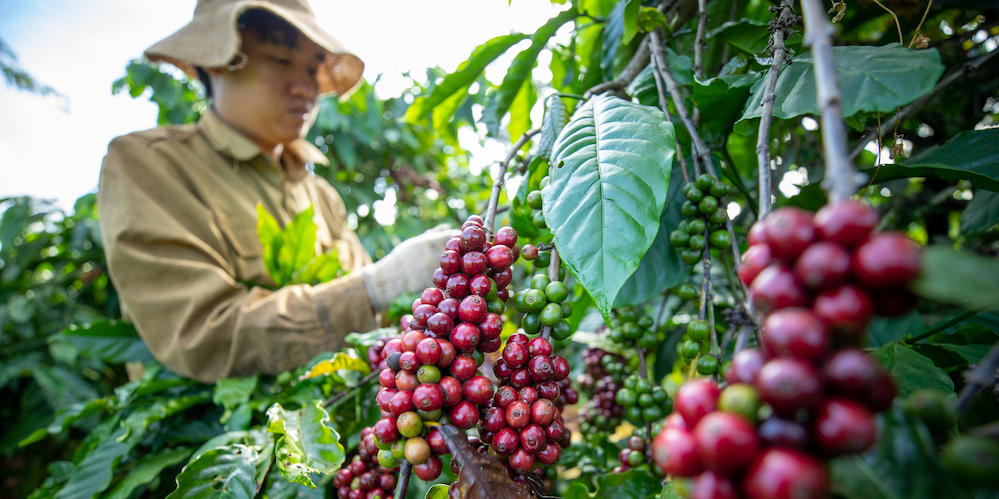Press and News Toward a sustainable coffee future in Vietnam’s Central Highlands

Through extensive research and international collaboration, the Alliance supports work to make coffee production in Vietnam a sustainable source of prosperity for smallholder farmers
Less than 30 years ago, Vietnam’s country’s coffee production barely registered on global output tables. Today, the Southeast Asian country is the world’s second-largest producer, a US$3 million export industry, second only to Brazil. Exponential growth in Vietnam’s coffee sector is emblematic of the country’s economic expansion of recent decades.
Continued positive growth in the coffee sector will rely on international collaboration, with several organizations, including the Alliance of Bioversity International and CIAT, working with the government, private sector, and smallholder farmers to safeguard coffee against a number of risks.
The risks include the climate crisis, deforestation, agronomy and economics. For example, coffee-growing practices in the central highlands have been responsible for deforestation and biodiversity loss, and contributed to water pollution – issues of which the government and partners including the Alliance are working to address.
Uniting national and international efforts
Stephan Weise, the Alliance’s managing director for Asia, said: “The Alliance is committed to working with government and local authorities, national research institutes, and a coalition of international partners and producers to increase the resilience of the coffee sector in Vietnam, allowing it to grow while safeguarding it from future shocks.”
Collaborative efforts between the Alliance, local farmers and the government to address coffee-sector risks cover emission reductions, forest conservation, land conversion, financial solutions, and various decision-support tools. The work aims to pave more sustainable future for the coffee sector, while contributing to the Vietnamese government’s commitments to global development frameworks.
The Vietnamese government, which helped propel the country’s coffee sector expansion, has already taken steps to enact new regulations and promote agroforestry. Currently, it is working with experts at home and around the globe to make the industry more resilient to today’s challenges and safeguard the livelihoods of the estimated 640,000 smallholders that are the backbone of the industry.

In the Central Highlands, the Alliance is working with partners to safeguard coffee against multiple risks related to climate, environment and economics. Credit: Trong Chinh/Alliance of Bioversity International and CIAT
Deploying state-of-the-art solutions
A pilot application of Terra-i, a satellite-imagery system developed by researchers from CIAT in 2006, with support from the United Nation’s Reducing Emissions from Deforestation and Forest Degradation (UN-REDD) program, was completed to monitor forest land-use changes, particularly forest conversion to coffee plantations in Di Linh district, Lam Dong Province. This collaborative work has led to an agreement to upscale the use of Terra-i as a tool for forest monitoring at provincial and national levels. Currently, the Lam Dong Provincial People Committee has adopted Terra-i and expanded its application at a provincial level.
As a next step, the European Union is working with the Alliance and Vietnamese government, together with the United Nations Development Programme, the United Nations Environment Programme, the European Forest Institute and the Sustainable Development initiative, is using state-of-the-art satellite-based real-time monitoring to implement deforestation-free coffee supply chains in Lam Dong and Dak Nong provinces.
Alliance scientist Louis Reymondin said: “This will increase sustainability, transparency, and traceability in the coffee supply chain and stimulate business sector investments.” Decision-support tools for climate services—including localized climate forecasts—and financial tools like insurance packages are also being implemented, to mitigate climate risk for coffee farmers in the Central Highlands.
Mitigating long-term climate risk
Coffee farmers are increasingly exposed to climate risks including longer droughts and less rain, which can destroy the flowering of crops. The German-based International Climate Initiative (IKI), the World Meteorological Association and the University of Southern Queensland in Australia are leading work on climate risk management systems, best practices, and insurance products; while the Nordic Climate Fund is addressing agricultural decision making, social science, and climate science with partners.
The viability of emission-reduction measures in the Central Highlands of Vietnam is central to forest conservation efforts, and the Alliance is also working together with the European Union-funded LAND-use based MitigAtion for Resilient Climate pathways project (LANDMARC) led by the Zurich University Swiss Federal Institute of Technology in Zurich.
Meanwhile, soil scientists are assessing plant health, soil health and productivity to assess the consequences of chemical input mismanagement in coffee and pepper plantations. Supported by the Australian Centre for International Agricultural Research, they are identifying methods to mitigate soil damage caused by pests and diseases in coffee plantations.
Alliance soil scientist Didier Lesueur said: “Agroecological practices such as the utilization of cover crops and legumes such as Crotalaria, have shown a significant negative impact on these pests and diseases,” helping to protect coffee farming in future.
These joint efforts in Vietnam’s Central Highlands are paving the way for the country to achieve nationally determined greenhouse gas emissions reductions and commitments within the coffee sector. Efforts continue to promote a more resilient and sustainable coffee sector, while taking joint steps internationally and nationally to address climate and other long-term risks.
This piece was originally published in VN Economy.
